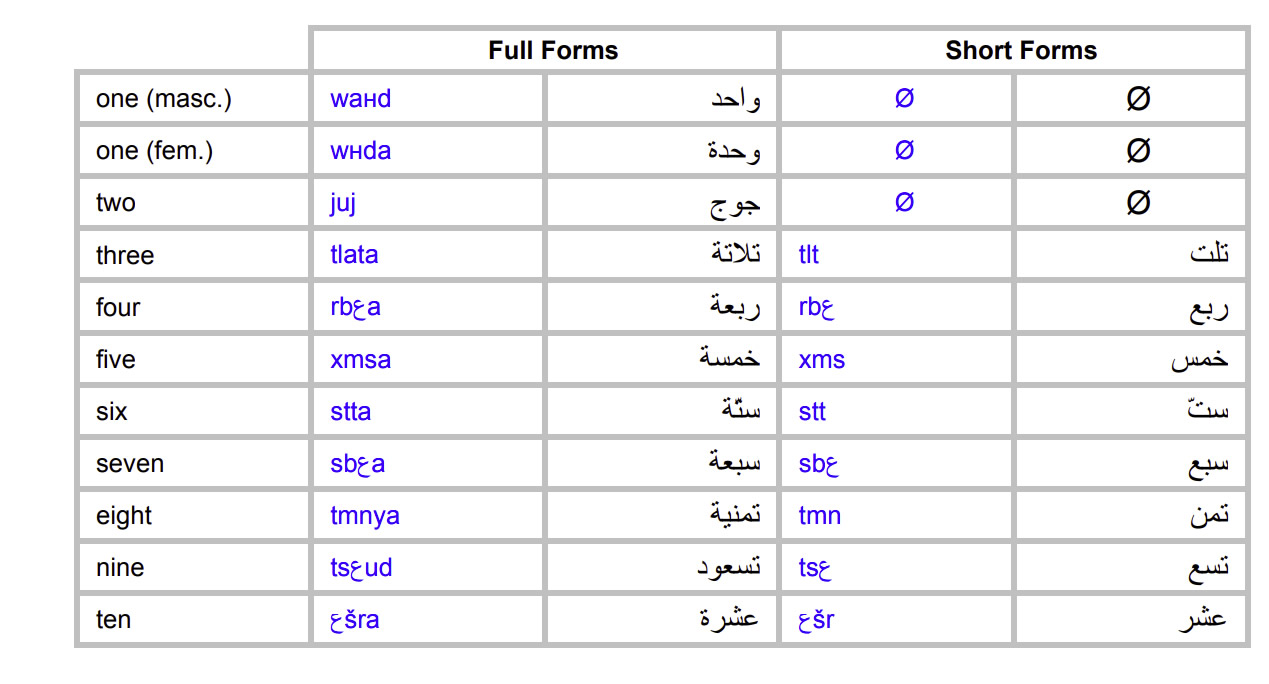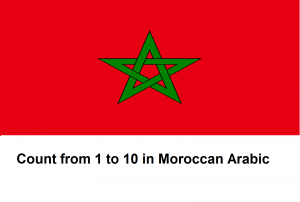Difference between revisions of "Language/Moroccan-arabic/Vocabulary/Count-from-1-to-10"
< Language | Moroccan-arabic | Vocabulary
Jump to navigation
Jump to search
| Line 27: | Line 27: | ||
The use of two different forms for the same numbers is a characteristic of Moroccan Arabic, which helps distinguish it from other Arabic dialects. | The use of two different forms for the same numbers is a characteristic of Moroccan Arabic, which helps distinguish it from other Arabic dialects. | ||
[[File:Moroccan-Arabic-Language-count 1 to 10 PolyglotClub.jpg]] | === [[File:Moroccan-Arabic-Language-count 1 to 10 PolyglotClub.jpg]] Examples === | ||
==== Full form: ==== | |||
# واحد كبير (wahad kteer) | |||
# اثنان كبير (ishaar kteer) | |||
# ثلاثة كبير (talata kteer) | |||
# اربعة كبير (arba'a kteer) | |||
# خمسة كبير (khamsa kteer) | |||
=== | ==== Short form: ==== | ||
3. ثلاث (talat) | |||
# اربعة (arba'a) | |||
# خمسة (khamsa) | |||
# ستة (sitta) | |||
# سبعة (sab'a) | |||
# ثمانية (thamania) | |||
# تسعة (tis'a) | |||
# عشرة (ashara) | |||
==== Example sentences: ==== | |||
# واحد كبير شاي (wahad kteer shai) | |||
# اثنان كبير كافيه (ishaar kteer kafee) | |||
# ثلاثة كبير حلال (talat kteer hlal) | |||
# اربعة كبير موكع (arba'a kteer mawke'a) | |||
# خمسة كبير بشور (khamsa kteer bachoor) | |||
===Count from 1 to 10 in Darija, Moroccan Arabic=== | ===Count from 1 to 10 in Darija, Moroccan Arabic=== | ||
<youtube>https://www.youtube.com/watch?v=n6Jc6jR02-o</youtube> | <youtube>https://www.youtube.com/watch?v=n6Jc6jR02-o</youtube> | ||
Revision as of 23:36, 12 February 2023
How to Count from 1 to 10 in Moroccan Arabic / Darija / Moroccan
Hello everybody,😊
In today's lesson you will learn to ¨COUNT FROM 1 TO 10¨ in Moroccan Arabic.
Feel free to edit this page by adding new numbers and expressions!
Happy learning! :)
Count to 10 in Moroccan Arabic
Full and Short Forms
In Moroccan Arabic, when combining numbers 3 to 10 with an object, there are two forms that can be used:
- The first form is the "full" or normal form of the number,
- and the second form is the "short" form of the number.
Here is a table that lists the full form of numbers 1-10 and the short form of numbers 3-10.
The use of two different forms for the same numbers is a characteristic of Moroccan Arabic, which helps distinguish it from other Arabic dialects.
 Examples
Examples
Full form:
- واحد كبير (wahad kteer)
- اثنان كبير (ishaar kteer)
- ثلاثة كبير (talata kteer)
- اربعة كبير (arba'a kteer)
- خمسة كبير (khamsa kteer)
Short form:
3. ثلاث (talat)
- اربعة (arba'a)
- خمسة (khamsa)
- ستة (sitta)
- سبعة (sab'a)
- ثمانية (thamania)
- تسعة (tis'a)
- عشرة (ashara)
Example sentences:
- واحد كبير شاي (wahad kteer shai)
- اثنان كبير كافيه (ishaar kteer kafee)
- ثلاثة كبير حلال (talat kteer hlal)
- اربعة كبير موكع (arba'a kteer mawke'a)
- خمسة كبير بشور (khamsa kteer bachoor)
Count from 1 to 10 in Darija, Moroccan Arabic
Numbers from 1-10 / ارقام من ١ الى ١٠ (Moroccan Arabic)
Nombres de 1 à 10 en arabe maroccain
